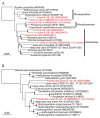Microbial communities associated with holothurians: presence of unique bacteria in the coelomic fluid
- PMID: 22446312
- PMCID: PMC4036045
- DOI: 10.1264/jsme2.me12020
Microbial communities associated with holothurians: presence of unique bacteria in the coelomic fluid
Abstract
Marine invertebrates interact with various microorganisms ranging from pathogens to symbionts. One-to-one symbiosis between a single microbial species and a single host animal has served as a model for the study of host-microbe interactions. In addition, increasing attention has recently been focused on the complex symbiotic associations, e.g., associations between sponges and their symbionts, due to their biotechnological potential; however, relatively little is known about the microbial diversity associated with members of the phylum Echinodermata. Here, for the first time, we investigated microbial communities associated with a commercially important holothurian species, Apostichopus japonicus, using culture-dependent and -independent methods. Diverse and abundant heterotrophs, mostly Gammaproteobacteria members, were cultured semi-quantitatively. Using the cloning and sequencing technique, different microbial communities were found in different holothurian tissues. In the holothurian coelomic fluid, potentially metabolically active and phylogenetically unique members of Epsilonproteobacteria and Rickettsiales were discovered. This study suggests that coelomic fluids of marine invertebrates, at least those inhabiting intertidal areas where physical and chemical conditions fluctuate, provide microbes with unique and stable habitats.
Figures




References
-
- Alekseeva SA, Bakunina IY, Nedashkovskaya OI, Isakov VV, Mikhailov VV, Zvyagintseva TN. Intracellular alginolytic enzymes of the marine bacterium Pseudoalteromonas citrea KMM 3297. Biochemistry (Moscow) 2004;69:262–269. - PubMed
-
- Brinkhoff T, Giebel HA, Simon M. Diversity, ecology, and genomics of the Roseobacter clade: a short overview. Arch Microbiol. 2008;189:531–539. - PubMed
Publication types
MeSH terms
Substances
Associated data
- Actions
- Actions
- Actions
- Actions
- Actions
- Actions
- Actions
- Actions
- Actions
- Actions
- Actions
- Actions
- Actions
- Actions
- Actions
- Actions
- Actions
- Actions
- Actions
- Actions
- Actions
- Actions
- Actions
- Actions
- Actions
- Actions
- Actions
- Actions
- Actions
- Actions
- Actions
- Actions
- Actions
- Actions
- Actions
- Actions
- Actions
- Actions
- Actions
- Actions
- Actions
- Actions
- Actions
- Actions
- Actions
- Actions
- Actions
- Actions
- Actions
- Actions
- Actions
- Actions
- Actions
- Actions
- Actions
- Actions
- Actions
- Actions
- Actions
- Actions
- Actions
- Actions
- Actions
- Actions
- Actions
- Actions
- Actions
- Actions
- Actions
- Actions
- Actions
- Actions
- Actions
- Actions
- Actions
- Actions
- Actions
- Actions
- Actions
- Actions
- Actions
- Actions
- Actions
- Actions
- Actions
- Actions
- Actions
- Actions
- Actions
- Actions
- Actions
- Actions
- Actions
- Actions
- Actions
- Actions
- Actions
- Actions
- Actions
- Actions
- Actions
- Actions
- Actions
- Actions
- Actions
- Actions
- Actions
- Actions
- Actions
- Actions
- Actions
- Actions
- Actions
- Actions
- Actions
- Actions
- Actions
- Actions
- Actions
- Actions
- Actions
- Actions
- Actions
- Actions
- Actions
- Actions
LinkOut - more resources
Full Text Sources
Molecular Biology Databases
Miscellaneous

